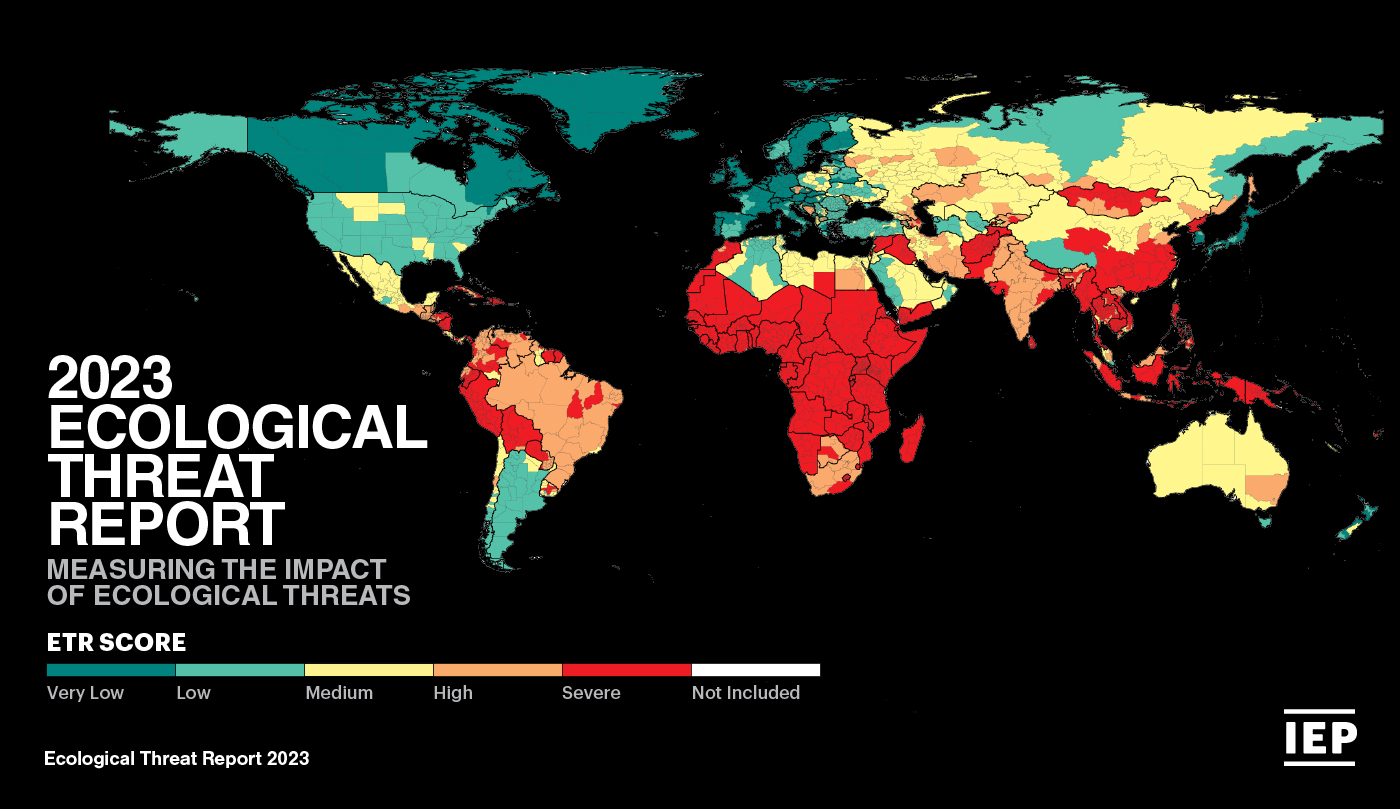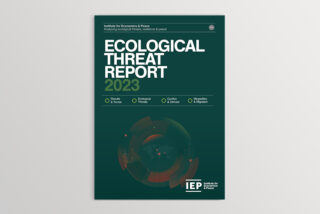London, November 1, 2023: Today marks the annual launch of the Ecological Threat Report, produced by the Institute for Economics & Peace (IEP).

Download the 2023 Ecological Threat Report
The Ecological Threat Report (ETR) analyses ecological threats globally and assesses the countries and subnational areas most at risk from conflict, civil unrest and displacement caused by ecological degradation and climate-related events. The report covers 221 countries and independent territories broken down into 3,594 subnational areas.
The main finding from the ETR is that without concerted action, current levels of ecological degradation will worsen, intensifying existing conflicts, and becoming a catalyst for new conflicts, thereby resulting in increases in forced migration.
The number of countries suffering from severe ecological threats and low societal resilience has risen by 3 to 30 in the last year. These ‘hotspot’ countries are home to 1.1 billion people, an increase of 332 million. The recent pressures on global food prices have placed additional demands on countries already suffering from food insecurity.
Three new countries have emerged as ‘hotspots’. They are Niger, Ethiopia, and Myanmar, all of which have entered a detrimental cycle of increasing ecological threats, lower societal resilience and escalating conflict. Each has faced famine and violence in the last 12 months: Ethiopia’s ongoing conflict, Niger’s recent military coup, and Myanmar’s violence following its coup in 2021.
Ecological degradation and conflict are cyclical, whereby the degradation of resources leads to conflict, while conflict leads to the degradation of resources. Ecological degradation has the biggest impact on conflict in regions like the Sahel, which face major deficiencies in governance, rule of law, high levels of poverty and short-term climatic variations.
Conflicts often spillover from one country into another, affecting the region and beyond. Currently there are over 108 million people that are displaced, up by 24% since 2020. Estimates show that 30 per cent of all displacements move more than 500 kilometres beyond their home country, with a significant percentage of illegal entries in Europe originate from ecologically threatened and conflict-ridden countries. A significant percentage of Europe’s illegal entries, notably 29% from Syrian and 9% from Afghanistan, are from hotspot countries.
Based on current trends, and without substantial efforts to reverse them, IEP estimates show that by 2050, 2.8 billion people will reside in countries facing severe ecological threats compared to 1.8 billion in 2023.
Food insecurity is connected to water stress. The ETR estimates that a 25% rise in food insecurity increases conflict risk by 36%, similarly a 25% increase in water risk escalates the likelihood of conflict by 18%. Areas with a history of conflict and weak institutions are the most vulnerable.
Global food prices have increased by 33% since 2016, placing further stress on the most vulnerable. Currently, 42 countries face severe food insecurity, with almost four billion people living in areas with high or severe food insecurity. Most of these countries are in Sub-Saharan Africa.
Two billion people currently live in countries without access to safe drinking water. By 2040, the MENA region will mirror sub-Saharan Africa’s water stress. Eight of the 12 countries in Russia and Eurasia currently face significant water challenges, exacerbated by low rainfall and their topology.
These trends are expected to worsen. It is likely that global warming will exceed 1.5°C during the 21st century, making it harder to stay below 2°C. This is likely to exacerbate ecological degradation and the underlying drivers of conflict.
Climate change amplifies risks such as droughts, flooding, cyclones and storms. Death rates are seven times higher in countries with low rather than high levels of resilience and peace. As such, in 2022 the UN Central Emergency Response Fund allocated 35% of its budget to tackling natural disasters, up from 17% a decade ago.
Increasing demographic pressures intensify ecological risks, straining public resources and societal resilience, especially in already vulnerable regions. By 2050, sub-Saharan Africa’s population is predicted to rise to 2.2 billion, an increase of over 60%, which will dramatically increase pressure on existing food and water supplies. By 2050, the number of youths under 15 in the region will account for more than the entire population of Europe, highlighting the dynamic changes in global population distribution.
Steve Killelea, Founder & Executive Chairman of IEP said:
“As we approach COP 28, the Ecological Threat Report provides a timely reminder of the need for leaders to act, invest and build resilience for the future. The number of countries with severe ecological threats that lack the necessary societal resilience to deal with these challenges keeps on increasing, and climate change will only exacerbate these threats.
Countries with high levels of Positive Peace have the societal resilience to solve these challenges. In a world facing increased ecological degradation, conflict and forced migration, world leaders need to invest in programmes that build the capabilities that create positive resilience and drive economic advancement.”
The number of megacities are on the rise and projected to increase from 33 to 50 by 2050. Over 267 million people currently live in the world’s least peaceful megacities. These cities will experience rapid growth over the next 30 years, but lack the financial resource to manage their expansion, resulting in increases in crime, poverty, traffic congestion, and pollution.
In Africa, both Nigeria and the Democratic Republic of the Congo have multiple high growth cities, with low per capita incomes. Of the 50 projected megacities, 60% are in countries in the bottom half of the Global Peace Index.
Over 60% of refugees and 80% of internally displaced people move to cities. By 2050, 70% of the global population will live in cities, with most growth occurring in countries with low per capita income and high levels of violence. Examples include Kinshasa, Lagos, Dhaka, and Karachi.
Countries that rely heavily on fossil fuels will struggle without assistance during the forthcoming green transition. For example, DRC, Libya, Iraq, Angola, and Timor Leste derive over 25% of their GDP from fossil fuels. Confronted with major ecological challenges and low societal resilience, these countries may face a decline in GDP of up to 60% between 2030 and 2040.
